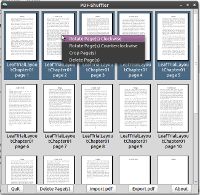This page details the software that we use. In many cases we use this software on GNU/Linux system, specifically Ubuntu, so if you only have a Windows or MacOS based system then you are going to have to re-think your workflow.
To speed up our projects we built a new desktop-grade machine with lots of memory and reasonable CPU running desktop Ubuntu- I detailed the rational for this here. This doesn’t have to be an expensive machine because you don’t need to have an expensive graphics card – built-in graphics on a modern Motherboard will suffice.
The software is listed in the order of importance to us to create books,
Scribus
This is the Desktop Publishing software that we have settled on. It has its quirks but we have successfully made our first complex book using this software and our Doctor Antonio book is available for purchase on the usual channels of Amazon, Createspace, Amazon.co.uk and whsmith.co.uk.
There are other competitive and commercial programs but they cost money but there are no other competitive Open Source programs that match the Scribus features. As part of our ideology of Open Mutual and Life Sign Press is to use a complete Open Source workflow then we trend to trying and using Open Source packages before we commit to commercial closed source packages. In time if Life Sign Press is successful, then we would hope to sponsor new features in Scribus that simplify the tasks that we have discovered are needed but for the moment it is fine.
Scribus is available for Windows and Linux platforms and is available from here. If you want a MacOSX version then please visit here. For our first project we have settled on using a specific version 1.3.9 which is now not available (it is up to 1.4.0rc5) but we don’t foresee any problems with backward compatibility (i.e. newer versions reading older versions – though the reverse is not true in that you can’t easily make old version of Scribus read a new version file). We built this from source on our Linux machine so we had full control over the build should we get half way through our project and need to patch something to make a feature work.
You will not have to do this. We haven’t see any problems that suggest any incompatibilities. You can just download and install the binary files or installers.
GIMP
GIMP is one of those programs that seems unable to break away from being compared to commercial competitors. Truthfully though a high-end commercial package isn’t going to make you a skilled compositor or re-toucher – that takes time and effort and the tools you use play second fiddle to your skill and ability to visualize what you desire and make it so in the medium of choice.
GIMP costs nothing and whilst it may not have all the features of a high-end commercial package, it is free and more than versatile enough. Download GIMP for different platforms from here.
We use GIMP mainly to crop and resize images. In very few cases we remove artifacts such as dirt marks on objects, or if necessary people, by cloning the surrounding areas. We use GIMP to blend images in layers.
We also use GIMP to make up logos, favicons and templates.
OpenOffice.org or LibreOffice
These two suites are more or less identical. Many years ago Sun Microsystems bought a German based company that had a product called StarOffice. Sun eventually open sourced StarOffice into a community and a commercial version. The community version is the OpenOffice.org that many people will be familiar with.
Recently Oracle bought Sun Microsystems and then got control of both Java and OpenOffice.org. There was some concern regarding this move so the community edition was “forked” into LibreOffice. The beauty of Open Source model is that this is permitted – anyone can take the source code and re-use this as long as they make the code available to others according to the terms of the license. This move costs nothing in money. Open Source software can and is sold (usually to get paid support) but it can also be downloaded for free and this is perfectly legal.
It is our view that the development cycle of LibreOffice is faster and LibreOffice also has one better feature for Europe and that is that for multi-language installs it is easy to add new languages (both the GUI and dictionaries). OO.org was tedious to find and install new and up to date localizations. Both OO.org and LibreOffice run on Windows, MacOS and Linux. We use this program to edit and spell check manuscripts prior to import into Scribus (because Scribus doesn’t have a very well integrated spell checker).
To download either program (we recommend LibreOffice) please visit here and pick the Operating System and the language variant. You can download directly or use BitTorrent. We recommend to use the BitTorrent option because this is a more stable means of downloading large files (the LibreOffice file size is out 160 MB for Linux and 190 MB for Windows).
PDF-Shuffler
 PDF-Shuffler main dialog
PDF-Shuffler main dialog
We use this to merge PDF files and to extract sample chapters or to trim PDFs of superfluous pages prior to word frequency analysis.
PDF-Shuffler is a simple utility which lets you merge, split and shuffle around PDF documents. You can also rotate and crop individual pages of a pdf document.
It is only available for GNU/Linux and will either be in your distribution package manager or available for download and building from http://sourceforge.net/projects/pdfshuffler/

